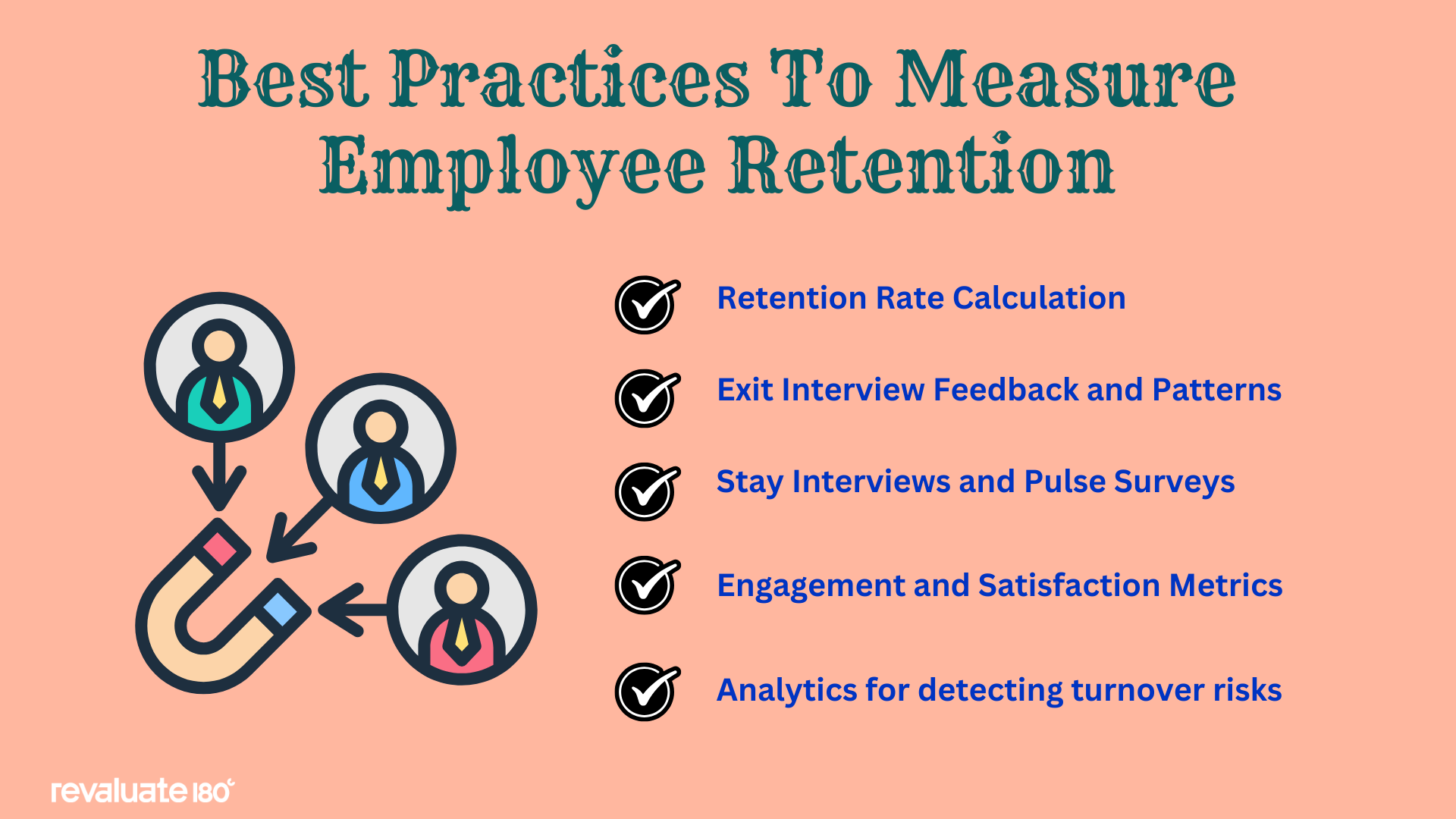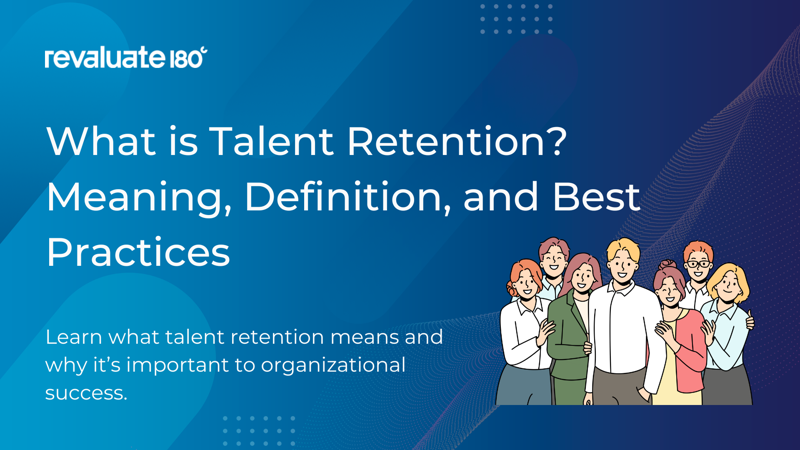Every organization faces the challenge of talent retention. Sudden recessions, massive layoffs, and uncertainty about jobs being replaced by AI often make employees anxious about their future with the company.
Market conditions and job quality can trigger employees to leave their company for better opportunities. The exit of several talented employees from a company would impact its business, leading to increased costs associated with hiring new candidates.
So, how can companies retain their talent that came from rigorous hiring rounds and evaluation? Let’s find out!
Key Takeaways
Talent retention is all about keeping your best people from leaving. This guide breaks down what it means, why it matters, and how you can build an effective talent retention strategy that improves performance and reduces turnover. You’ll also learn how smart tools and people analytics, like those offered by solutions such as Revaluate180, can help future-proof your workforce.
Talent Retention: Meaning and Definition
The precise definition of talent retention is the all-around effort undertaken by a company to ensure its employees’ needs and expectations are met, making them feel satisfied and happy to work without anxiety or fear. Effective compensation, along with a retention bonus, proper work-life balance, sufficient opportunities for career growth and development, and peer recognition, contribute to talent retention.
Talent retention has multiple meanings that evolve in response to changing employee needs. In today’s job market, talent retention involves providing a flexible work environment that allows employees to work remotely or choose between working from home or the office.
Additionally, employees seek benefits beyond their compensation package, such that the job they do gives them a sense of purpose and motivation to come to work, and they avoid thinking of changing companies or jobs.
Why is Talent Retention Important?
It is not enough for companies to stop with just hiring the right candidates for the right job roles. Companies must consistently invest in retaining these employees so that they contribute to the company’s business and growth for an extended period, regardless of market conditions.
Here are some reasons why retaining your current employees is beneficial for the company:
- Saves Costs: Employees who leave the company within the first year often result in companies losing approximately 33% of the employee’s salary. Similarly, the costs of rehiring, onboarding, and training new employees add to expenses. In comparison, the costs of retention initiatives are minimal compared to those of repetitive hiring and turnover.
- Knowledge Retention: Employees who remain in the company for extended periods often possess better experience and expertise to address business challenges. Long-term employees can easily tackle a similar problem in the future.
- Improved Productivity: When companies provide sufficient opportunities for learning, career development, and work-life balance, employees are fully charged to focus on their work tasks. Naturally, they remain less anxious about uncertainties in their job, or avoid thinking of seeking other opportunities.
- Strong Organizational Culture: The more experienced employees a company has, the more candidates will be willing to join and gain first-hand experience. New hires often turn to experienced employees for help and support, showing a healthy culture of employee engagement.
- Enhanced Customer Experience: A company's treatment of its employees is a direct reflection of its treatment of its business clients and customers. Enhanced efforts toward talent retention are evident in the company’s deliverables and services, which in turn improve the customer experience.
Pillars of an Effective Talent Retention Strategy
Achieving optimal talent retention requires understanding what employees need to remain with the company. Here are some of the retention strategies that can influence your employees to work in your company without thinking about switching.
1. Competitive Compensation and Benefits
A compensation package that is the best for a given job role in the current job market is always the primary driver for employee retention. Often, employees switch companies due to better compensation packages, which companies can avoid by providing reasonable salaries and growth incentives.
Additionally, benefits and upgrades to health insurance, vehicle lease policies, house rent allowances, desk setup costs in cases of remote work, and other financial incentives help employees remain with the company.
2. Positive, Inclusive Company Culture
A happy workplace is where employees feel they belong. Does that mean all employees are of one kind? Absolutely not!
A positive and happy workspace often features diverse employees from different backgrounds, yet they remain united through shared work goals. No wonder companies are hiring employees from diverse backgrounds.
Companies must celebrate diversity and value employees for their work regardless of their ethnicity, education, age, or gender. This creates a sense of belonging, where employees never feel anxious or left out.
3. Recognition and Reward Programs
Employees feel valued when they are recognized and appreciated for their timely effort toward their work that makes a significant business impact. Honoring them with rewards and appreciation gives a sense of pride in accomplishing something significant.
A well-designed recognition program or company portal with flexible reward options not only makes employees happy but also motivates them to perform better, serve as role models, and exceed expectations.
4. Flexible Work Arrangements and Work-Life Balance
In today’s work scenario, especially post the COVID-19 lockdown phases, several employees are now valuing flexible work options. In fact, some are even willing to accept a lower compensation, considering they are allowed to work remotely or come into the office for a few hours on certain days.
Flexible work has been an excellent way for many companies to let their employees achieve a perfect work-life balance. Spending the right amount of time at work without distractions and also spending quality time with loved ones is crucial for employees’ mental health. When companies prioritize employees’ well-being, they experience lower turnover rates.
5. Career Growth and Development Opportunities
Employees join a company with the vision and expectation of growing in their careers and advancing to higher designations within a specified timeframe. Companies that fail to support employees in their career progression often lose their best talent to competitors who offer promotions along with better pay packages.
Companies must conduct periodic performance appraisals for all levels of employees to consistently review their growth opportunities. Opportunities for skill development, distance learning, leadership training, and other workshops must be mandatory provisions in all companies. Managers must make a concerted effort to gather their team members' career goals and guide them on how to achieve them while working at the company.
6. Employee Feedback and Two-Way Communication
Companies that listen to their employees and provide sufficient channels for them to communicate their concerns often see less turnover. The more channels employees have to share their feedback, the better the company can understand its employees.
Some employees may prefer to share anonymous feedback on common portals, while others may need to discuss specific issues with their leaders or HR business partners to gain more clarity. Any new initiative, company internal communications, employee engagement activities, work-related goals, and several other programs must ensure that the employees share their feedback with the concerned professionals.
7. Purpose-Driven Work and Leadership Transparency
Often, new hires find themselves a misfit for a job role because their job expectations do not match reality. Communication barriers between several levels of leadership can make employees anxious about their careers and future in the company.
For these reasons, companies must ensure that employees are well-briefed about their job roles, the purpose they will serve, and how their contributions will impact the business. Furthermore, team and group leaders must be transparent in their communication and recognition of the right individuals, encouraging them to perform at their best.
8. Personalized Retention Using Data and Behavioral Insights
Artificial intelligence has found its way into almost every technical field, especially AI’s role in recruitment, retention, and employee engagement is now unavoidable. Thanks to data-driven insights from AI-powered algorithms, employers can gain personalized information on the motivational factors that drive each employee.
Such patterns can provide accurate predictions on how companies can prevent massive turnovers, avoid costly hiring mistakes, and improve retention by analyzing past patterns and employee data. Employee behavioral insights, as revealed through attendance, work performance, and participation in engagement initiatives, can indicate potential turnover.

Unlock AI-Powered Hiring Analytics
Transform the way you hire with insights that create aligned, collaborative, and high-performing teams.
 Smarter Hiring Decisions
Smarter Hiring Decisions
 Reduce Expensive Turnover
Reduce Expensive Turnover
 AI-Driven Insights
AI-Driven Insights
 Optimize Team Performance
Optimize Team Performance

How to Measure Talent Retention Success
Whether you already have a robust set of retention initiatives or are looking to implement reforms and add new talent retention strategies, it is essential to assess their efficiency regularly.
Here are some tools and metrics to help you gain clear insights into your company's talent retention performance.

1. Retention Rate Calculation
This metric helps companies understand the number of employees they have retained over a given period. The retention rate can be calculated quarterly, semiannually, and annually to understand trends and patterns in employee exit and retention.
To calculate the retention rate, get the number of employees enrolled with the company at the start and end of a given period. Subtract the value to find the number of employees remaining, and divide it by the number of employees at the beginning of the period. Now, multiply this value by 100 to obtain the retention rate as a percentage.
This value is similar to the turnover rate, which indicates the number of employees who have left the company during the same period. Here is an easy turnover rate calculator to determine how your company is faring in talent retention.
2. Exit Interview Feedback and Patterns
Exit interviews are informal sessions in which an HR business partner speaks to an exiting employee after all the formalities are done. Such interviews are often the last resort, where employees open up with HR partners about the actual reasons that led them to decide to leave.
Feedback from such interviews provides insight into the reasons and patterns of employee exit. Such insights can be further evaluated by company leaders, along with AI-powered tools, to understand how companies can prevent such incidents in the future. Here is a list of exit interview questions you can ask your exiting employees for better analysis.
3. Stay Interviews and Pulse Surveys
Unlike exit interviews, stay interviews are often conducted by team leaders or HR business partners periodically to understand how the employee feels about their work and the company. Employees’ feedback during such interviews helps companies take preventive measures to avoid possible turnover.
Pulse surveys are quick, 5-10 minute surveys that help gather feedback on initiatives, team activities, work tasks, and many other topics. Such surveys can be conducted online, and team leaders must encourage their members to share their honest opinions. Results from stay interviews and pulse surveys can be analyzed using AI tools to provide accurate insights into how current talent retention initiatives are helping the company.
For instance, here we have a list of survey questions while onboarding employees.
4. Engagement and Satisfaction Metrics
Companies must improve employee engagement to achieve higher retention rates. Several employee engagement initiatives can help make every employee feel valued and motivated to work more effectively.
Every initiative must have active participation from employees and also get their feedback. Team leaders can be the best judges to analyze how each team member is involved in work and team bonding activities. This employee engagement and satisfaction-related data can be collected from leaders and managers to understand how the company can help them engage better.
5. Using Analytics to Detect Turnover Risk Early
HR professionals or C-Suite leaders may themselves not remain in a company for long. A lack of such experienced professionals can make it difficult for companies to predict and handle unforeseen turnovers.
Thankfully, several AI-powered tools provide accurate insights based on the company's comprehensive employee records. By analyzing past exit patterns, analytics from such tools accurately predict why employees may leave the company in the future and how companies can take preventive measures. Leveraging AI in employee retention is something that companies cannot afford to skip today.
Common Challenges in Retaining Top Talent
In today’s work atmosphere, here are some of the common challenges that employers face while coming up with talent retention strategies and initiatives:
1. Rising Employee Expectations
No matter how many benefits companies offer, employees are always seeking more. If they find a peer company or a competitor offering the benefits they expect, employees do not hesitate to leave their current job and switch to that one quickly.
For such reasons, companies must be aware of the compensation and benefits provided by their competitors in the market. They must ensure that their employees are given what they deserve and honor valid requests for benefits that can help them.
2. Burnout and Disengagement
At times, client and business requirements expect employees to push themselves out of their comfort zone and put in more effort to achieve a work goal. This can temporarily affect their work-life balance.
Frequent or extended periods of such work can lead to burnout, causing employees to gradually disengage from their work. They may start looking for opportunities that offer more flexibility and time to rejuvenate.
3. Lack of Career Growth Opportunities
Employees often compare themselves with their college peers or other work colleagues to see how they have grown since joining the company. Not ascending the corporate ladder or remaining stagnant in the same position for a long period often motivates employees to switch companies.
Companies must ensure that employees grow in their job roles by providing them with the right opportunities and support. If someone remains stagnant in a position for an extended period, the company can provide them with the necessary training to help them grow professionally.
4. Poor Leadership Communication
The first step to successful employee engagement is when leaders lead by example. Employees come forward to voice their concerns and provide feedback only when they see their managers, group leaders, and company executives doing the same.
Failing to communicate effectively with lower-level employees or lacking transparent communication often creates anxiety among employees. That is why companies must focus on periodic behavioral training for leaders to ensure they communicate effectively.
5. Generational Differences and Work Style Preferences
The current workforce comprises a growing number of millennials and Gen Z employees. Companies have noticed significant differences in expectations from millennials and their Gen Z counterparts.
Team leaders are finding it challenging to get employees from these categories to work together, as Gen Z increasingly prefers to be individual contributors while prioritizing their work-life balance. As a result, companies must make a concerted effort to cater to the diverse needs of different employee generations.
A Smarter Way to Retain Talent with Behavioral Insights
Several companies are struggling to identify the blind spots that prevent talent retention. Revaluate180 can help companies identify their collective strengths and remove barriers to ensure maximum retention.
Our data-driven model provides accurate analytics by tracking employee performance and satisfaction levels during different stages of the employee lifecycle. We provide AI-powered insights that help companies make informed decisions about initiatives best suited for retaining their talented employees.
Furthermore, we offer initiatives to support individual employee development, helping employees advance in their careers while they are with the company. Implementing such programs from the onboarding journey has helped companies retain the maximum talent.
Final Thoughts

Talent retention is crucial for companies to retain the best talent they have hired, after investing sufficient time and resources. Employee turnover and frequent rehiring often indicate that employees are not satisfied with the company and its culture.
Such an image can significantly impact the company's business landscape, leading to increased turnover and loss of clients and customers. Companies must always be vigilant and monitor their employees' satisfaction levels to ensure maximum employee retention.
We discussed some key talent retention strategies and explored how companies can overcome challenges in retaining talent. If you require further assistance in evaluating your talent retention strategies, please don't hesitate to contact us.

Unlock AI-Powered Hiring Analytics
Transform the way you hire with insights that create aligned, collaborative, and high-performing teams.
 Smarter Hiring Decisions
Smarter Hiring Decisions
 Reduce Expensive Turnover
Reduce Expensive Turnover
 AI-Driven Insights
AI-Driven Insights
 Optimize Team Performance
Optimize Team Performance

FAQs
1. What is the meaning of talent retention?
Talent retention refers to the overall efforts taken by the company to ensure that its employees are satisfied while working there and do not think of switching to another job in another company.
2. What are the 5 C’s of retention?
The 5 C’s of employee engagement are highly relevant to employee retention, which companies must diligently follow.
- Care: Be conscious and concerned about employees’ overall wellness.
- Contribute: Value the contributions, ideas, and suggestions given by employees to various work tasks and company initiatives.
- Connect: Bolster healthy relationships among employees and between leaders and team members.
- Congratulate: Recognize and reward employees for their effort, irrespective of the small or significant business impact.
- Coach: Regularly train your employees to help them upskill and be the best talent in the marketplace.
3. What is key talent retention?
Key talent retention refers to the strategic retention of high-performing talent within the company. Losing such talent can lead to a significant loss, as the company must spend a lot of time hiring a candidate with similar or higher proficiency. If such key talents are important team members, their departure can significantly impact the team’s work dynamics.
4. What does retention mean in HR?
Retention management is an HR concept that refers to the steps taken by a company to safeguard or maintain its existing employee count. The HR department must periodically calculate the employee retention rate to assess the company's retention performance and identify areas for improvement in subsequent periods.
